Drum machine development
by Johan Liljencrants
With that new punchy trumpet sound on my organ I more prominently
miss
any drums for pop music making. I am now underway implementing my
dreams
of a miniature bass drum. There is some little space available inside
the
cabinet, beside and top of the reservoir, but nowhere like as big as a
conventional bass drum.
Inspired from the African 'djembe' drum my focus is on a membrane
driving
a Helmholtz resonator. In its fundamental mode this is precisely the
same
kind of device as a bass reflex loudspeaker.
In available space I can put a box 360*360*150 mm (14*14*6 in),
about
14 liters internal volume. The Helmholtz resonance frequency formula is
F = c*sqrt(S/LV)/2pi, where S is port area, L is port length, and V is
cavity volume. Using that, with a 'port tube' length of L=600 mm (24
in)
and a frequency F=50 Hz (arbitrary selections) the required port area
is
about S=0.8 dm^2 (12 in^2). This is OK for space, but only the easy
part
of the design problem.
The classical and most simple bass reflex speaker dimensioning rule
is twofold:
#1. The speaker element and the box resonance frequencies are to be
about the same.
#2. The box volume and the 'equivalent volume of the speaker
suspension'
are to be about the same.
Item #2 is a bit complex and has to do with the impedance matching
between
driver and filter. To loudspeaker freaks this concept is conveyed by
the
Thiele-Small parameter Vas. The driver (loudspeaker
element/membrane) has
a mechanical compliance Cm (meter/Newton). This is converted
into an acoustical
compliance Ca = Cm*S2 (meter5/Newton),
where S is the membrane area.
Finally you can derive the desired parameter from the elementary
formula
for the acoustic compliance of a volume Ca = Vas
/(rho*c2), where c=343
m/s is speed of sound and rho=1.2 kg/m3 is density of air.
To say the same thing in words alone: When you exert a certain air
pressure
rise on the membrane, then it will yield somewhat and allow for a
certain
small volume displacement (distance yielded, times area). Similarly,
when
you put pressure on a closed cavity, then its internal air is condensed
and will allow an additional volume of air to enter. Vas is
the cavity
volume required to accept the same displacement volume as the membrane,
when you put the same pressure rise to the two.
Just by intuition I made a 'membrane' covering the 360 mm square end
of the box from 4 mm birch plywood. Then measured its mechanical
compliance
to find that it was depressed by 0.5 mm when loaded by a weight of 2 kg
at its middle. About 0.0005 meter and 20 Newton, resulting in
Cm=1/40000
m/N. Assuming an effective membrane area to be 6 dm2
(0.6*total
area - membrane bulges much in its middle, but less toward its edges)
results
in Vas = 13 liter. Yipee! - good luck to be just right from the
beginning!
Then, to satisfy rule #1 the membrane must be tuned to the same 50
Hz.
Using the basic mass-spring resonance formula (2*pi*F)2*Mm*Cm=1
tells
that I should load the membrane at its middle with a mass Mm=0.4
kg. Implemented
that with a couple of 120 mm dia. wooden disks, a few washers and a
bolt.
Final thing is to equip the beater hammer with an adequately soft
stud.
Beyond this optimization of the drum sounding body comes the question
of
its excitation. Weight, arm length, and throw for the beater, its
energy
and response delay time.
I have so far made a beater mechanism console that holds two
replicas
of my harp beaters, acting near the edge of the drum. Between those is
a bigger motor (100 mm long by 160 mm wide) to hit the middle of the
membrane,
with 'inverted' control. I.e. the hammer is held away from the drum by
the pressurized motor pneumatic, and the active stroke is given by a
spring
when the pneumatic is evacuated by a wide aperture valve.
My preliminary tests tell me that plywood 'drumskin' does not sound
quite
as I would like, so I just visited a special drummer's shop nearby to
get
me a 12" drumskin with spanner ring and a tiny 8" splash cymbal for
further
experimentation.
Now, after several weeks I find all parts are there to the extent I
can make live tests. First a few pictures of what the drum machine
looks
like.
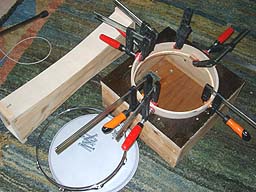 This
is various parts of the drum at the time I glued the seating ring for
the
drumskin from two layers of 4 mm birch plywood. The ring rests in a
circular
cutout in its baffle, lying on top of the square resonator box. Each
layer
ring is made from two strips plus a 30 deg. wedge such that I could
expand
each ring tightly against the baffle hole. The clamps hold the ends of
the strips in shape. The box has a hole in its back (obscured by the
clamps
with handles extending SouthWest). That hole connects to the port - the
long, waisted pipe at top left. It seems I am becoming an expert in
gluing
curved plywood parts.
This
is various parts of the drum at the time I glued the seating ring for
the
drumskin from two layers of 4 mm birch plywood. The ring rests in a
circular
cutout in its baffle, lying on top of the square resonator box. Each
layer
ring is made from two strips plus a 30 deg. wedge such that I could
expand
each ring tightly against the baffle hole. The clamps hold the ends of
the strips in shape. The box has a hole in its back (obscured by the
clamps
with handles extending SouthWest). That hole connects to the port - the
long, waisted pipe at top left. It seems I am becoming an expert in
gluing
curved plywood parts.
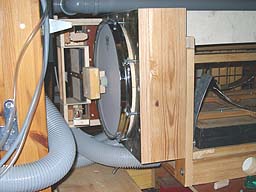 Next
picture shows the whole thing in place in the organ, left of the
reservoir,
with the port tube resting on top of it. The bass drum hammer hits the
center of the drumskin and is simply two wood blocks screwed together,
with felt and leather wrapped on one of them to form a pad.
Next
picture shows the whole thing in place in the organ, left of the
reservoir,
with the port tube resting on top of it. The bass drum hammer hits the
center of the drumskin and is simply two wood blocks screwed together,
with felt and leather wrapped on one of them to form a pad.
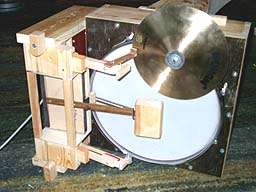 Here
is the assembled device outside, with also the little cymbal mounted.
The
beater pneumatics all sit on an incredibly complicated shelf, one that
was initially a simple plank, later sawed apart and staggered. This
shelf,
as well as the cymbal can be easily removed without tools, they are
held
by eccentric wooden handles - those for the beater shelf are at left,
top
and bottom. The cymbal came out louder that I expected. From its beater
backcheck there extends an arm toward the cymbal with a felt damper
pad.
This damper is not efficient enough. It seems I should use two damper
pads,
90 deg apart on the cymbal circumference.
Here
is the assembled device outside, with also the little cymbal mounted.
The
beater pneumatics all sit on an incredibly complicated shelf, one that
was initially a simple plank, later sawed apart and staggered. This
shelf,
as well as the cymbal can be easily removed without tools, they are
held
by eccentric wooden handles - those for the beater shelf are at left,
top
and bottom. The cymbal came out louder that I expected. From its beater
backcheck there extends an arm toward the cymbal with a felt damper
pad.
This damper is not efficient enough. It seems I should use two damper
pads,
90 deg apart on the cymbal circumference.
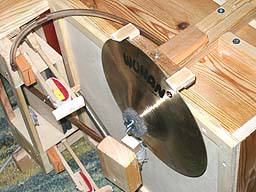 Now
the latest rebuild, and with the plywood membrane installed. The cymbal
is damped by two pads pressed radially against its edge. When the
hammer
mechanism is actuated the same air pulse goes by the plastic tube into
a small pneumatic, mounted on the cymbal holder arm (top right), which
lifts the dampers. Below the cymbal hammer you see a coil spring that
pulls
the bass drum hammer. The spring arrangement for that hammer is
actually
the most difficult one to implement. Ideally it should be some kind of
a compass or torsion spring, with a center of rotation coinciding with
the pneumatic hinge. No space available for that. I don't think the
present
solution is ideal, but it is simple and it works.
Now
the latest rebuild, and with the plywood membrane installed. The cymbal
is damped by two pads pressed radially against its edge. When the
hammer
mechanism is actuated the same air pulse goes by the plastic tube into
a small pneumatic, mounted on the cymbal holder arm (top right), which
lifts the dampers. Below the cymbal hammer you see a coil spring that
pulls
the bass drum hammer. The spring arrangement for that hammer is
actually
the most difficult one to implement. Ideally it should be some kind of
a compass or torsion spring, with a center of rotation coinciding with
the pneumatic hinge. No space available for that. I don't think the
present
solution is ideal, but it is simple and it works.
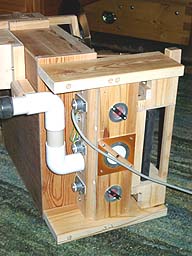 A
rear view showing the valve unit. The air intake and three Reisner
chest
magnets reside on a removable 'control board', screwed to the left side
of the valves. The big brown seat for the bass drum valve is cut out
from
a scrapped hard disk. The pneumatic shelf is screwed to the right side
of the valve unit. These three units can be pulled out together when I
release the locking handles, one visible at top right.
A
rear view showing the valve unit. The air intake and three Reisner
chest
magnets reside on a removable 'control board', screwed to the left side
of the valves. The big brown seat for the bass drum valve is cut out
from
a scrapped hard disk. The pneumatic shelf is screwed to the right side
of the valve unit. These three units can be pulled out together when I
release the locking handles, one visible at top right.
Experiences so far are mixed.
Bass drum: The original plywood 'drumskin' with dimensioning for a
bass
reflex speaker made a reasonably clear 'bump', but not loud enough to
me,
and rather tonal. The genuine drumskin gives a louder 'sock' sounding
more
genuine to me. I begin to think bringing in the bass reflex principle
might
be a mistake. Hammer weight is about 100 grams, causing a delay of
about
100 ms from electrical signal to beat. Must be compensated for in the
musical arrangement.
Also, do you remember the anecdote of one band member asking another
at a gig:
- How late do we play tonight?
- One quarter beat after the drummer!
It is important the drive signal should be of correct duration,
about
those 100 ms. If too short the beat is weakened, perhaps a useful
feature.
If too long, the hammer bounces to give multiple beats of dereasing
force
- the energy transfer from hammer to drumskin is pretty inefficient.
Later I thinned the plywood membrane to about 2.7 mm (two plies left
of original three) to make it more compliant at its edge, while the
about
100 mm dia. center portion was untouched. This was quite successful to
bring bass drum action right. Compliance about doubled, so I removed
half
the ballast weight at its middle and got some more response in sound
level.
Small drum beats are very 'hard', but may be moderated putting a
softening
leather pad on the hammer.
Here are spectra and sound clips for the bass drum (center hammer)
and
the small drum (bottom hammer, near the edge). The two alternatives
using
a regular 12" drumskin and the thinned plywood membrane. The final
sample
is very hard and bright, the hammer is plain hardwood, with no leather
pad.
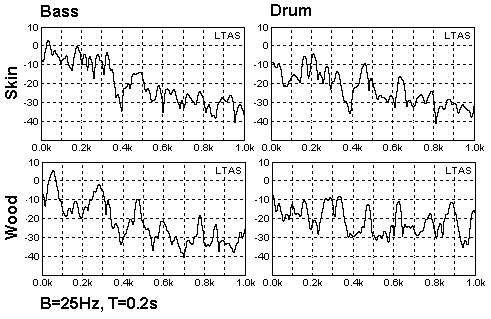
Bass, drumskin
Bass, plywood
Small drum, drumskin
Small drum, plywood
Small drum (lower beater): So far not quite in order. Sounds most
like
a wood block with the plywood membrane, and is too meek with the
drumskin.
With the drumskin perhaps I could glue on a hard little pallet where
the
beater hits. Or a flat box with hails in it to simulate a snare.
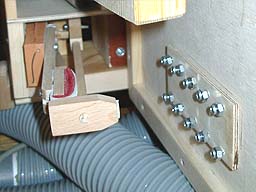 I
tried various ways to shape the small drum sound. With a hard wood
beater
on the plywood it is too distinct and brutal (sample above), with a
leather
pad (like in this picture) on the beater it makes somewhat more sense.
Since it would probably be good trying to mimick a snare drum I tried a
few variations on the rattle theme. The picture shows one of them.
A little 40*100 mm plywood bridge with a number of plate screws into
it.
Each screw holds an oversize nut, but loosely, so it is free to rattle.
The bridge is glued with two intervening thin felt pads to the plywood
'drumskin'. The hammer beat is additionally softened by these
(invisible)
felt pads. A drawback is that they rattle also with the bass drum
beats,
but I don't think this is disturbing in practice. - Against better
knowledge
I also tried a 'jingle bell' on the hammer head, a small sheet metal
container
with loose nuts inside. Complete failure: this comes out like a bounce
free hammer that does not rebound to the backcheck, so repetition rate
was severely hampered.
I
tried various ways to shape the small drum sound. With a hard wood
beater
on the plywood it is too distinct and brutal (sample above), with a
leather
pad (like in this picture) on the beater it makes somewhat more sense.
Since it would probably be good trying to mimick a snare drum I tried a
few variations on the rattle theme. The picture shows one of them.
A little 40*100 mm plywood bridge with a number of plate screws into
it.
Each screw holds an oversize nut, but loosely, so it is free to rattle.
The bridge is glued with two intervening thin felt pads to the plywood
'drumskin'. The hammer beat is additionally softened by these
(invisible)
felt pads. A drawback is that they rattle also with the bass drum
beats,
but I don't think this is disturbing in practice. - Against better
knowledge
I also tried a 'jingle bell' on the hammer head, a small sheet metal
container
with loose nuts inside. Complete failure: this comes out like a bounce
free hammer that does not rebound to the backcheck, so repetition rate
was severely hampered.
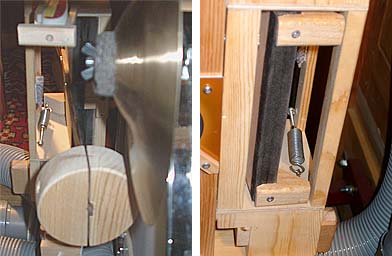 04-02-04:
Following principles suggested by Zeb Vance, I improved the bass hammer
spring
system. Two adjustable springs, one each end of the pneumatic, pull
yokes
near the hinge of the moving leaf. There are heels on these yokes going
down to cover the pneumatic hinge over both its leaves. These heels
unload
the hinge from the rather substantial spring force that would otherwise
tend to skew and tear off the motor cloth, glued to the leaf edges. I
also
made a somewhat more agreeable bass beater hammer head, 80 grams. Its
shaft
is a fairly springy hardwood rib. When the motor collapses this shaft
is
halted by an adjustable bracket (barely visible below the gray felt pad
holding the cymbal) when the hammer is some 10 mm away from the
drumhead.
The shaft is rigidly bolted to the driver leaf, still probably a good
deal
more elastic than necessary.
04-02-04:
Following principles suggested by Zeb Vance, I improved the bass hammer
spring
system. Two adjustable springs, one each end of the pneumatic, pull
yokes
near the hinge of the moving leaf. There are heels on these yokes going
down to cover the pneumatic hinge over both its leaves. These heels
unload
the hinge from the rather substantial spring force that would otherwise
tend to skew and tear off the motor cloth, glued to the leaf edges. I
also
made a somewhat more agreeable bass beater hammer head, 80 grams. Its
shaft
is a fairly springy hardwood rib. When the motor collapses this shaft
is
halted by an adjustable bracket (barely visible below the gray felt pad
holding the cymbal) when the hammer is some 10 mm away from the
drumhead.
The shaft is rigidly bolted to the driver leaf, still probably a good
deal
more elastic than necessary.
Here the 'real' drumhead is reinstalled, I believe this is the one I
will keep, for authenticity and for looks.
04-02-07:
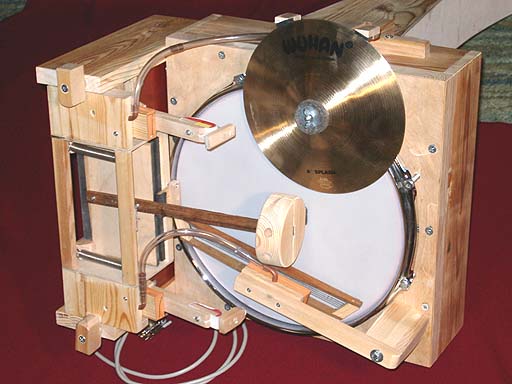
Final solution approaching. A light frame holds four thin coil springs
across the drumhead. The middle of the frame
is hinged to a small preumatic, fixed on an arm to hold all in place,
extending from low right in the picture. The snare frame is pressed
against
the drumhead in synchrony with the drum beater pneumatic. When
deactivated
the frame is lifted off a few millimeters by a staple return spring at
its pneumatic hinge. A detail refinement is at the tube connection next
to the beater pneumatic.
This makes for no snare action with the bass drum, unless the
'small' drum goes
simultaneously. There is an extra little snare noise coming from the
frame
being smashed into the drumhead. Only snag is that its sound level is
still on
the weak side, perhaps the motor should have been bigger. Maybe one
could
do with two beaters in order to double repetition rate from the present
max about 8/sec.
Here the cymbal is equipped with a damper, two felt clad pegs at its
top rim. These were later joined by a felted curved bridge to improve
damping. The damper is lifted by a small pneumatic, connected by a tube
in parallel to the beater driver pneumatic. - The duration of the
cymbal 'note' signal is significant. With a short one (50 ms) you get
something like a closed high hat beat. With a longer one there is a
range up to more like a splash cymbal.
 This
is various parts of the drum at the time I glued the seating ring for
the
drumskin from two layers of 4 mm birch plywood. The ring rests in a
circular
cutout in its baffle, lying on top of the square resonator box. Each
layer
ring is made from two strips plus a 30 deg. wedge such that I could
expand
each ring tightly against the baffle hole. The clamps hold the ends of
the strips in shape. The box has a hole in its back (obscured by the
clamps
with handles extending SouthWest). That hole connects to the port - the
long, waisted pipe at top left. It seems I am becoming an expert in
gluing
curved plywood parts.
This
is various parts of the drum at the time I glued the seating ring for
the
drumskin from two layers of 4 mm birch plywood. The ring rests in a
circular
cutout in its baffle, lying on top of the square resonator box. Each
layer
ring is made from two strips plus a 30 deg. wedge such that I could
expand
each ring tightly against the baffle hole. The clamps hold the ends of
the strips in shape. The box has a hole in its back (obscured by the
clamps
with handles extending SouthWest). That hole connects to the port - the
long, waisted pipe at top left. It seems I am becoming an expert in
gluing
curved plywood parts.
 Next
picture shows the whole thing in place in the organ, left of the
reservoir,
with the port tube resting on top of it. The bass drum hammer hits the
center of the drumskin and is simply two wood blocks screwed together,
with felt and leather wrapped on one of them to form a pad.
Next
picture shows the whole thing in place in the organ, left of the
reservoir,
with the port tube resting on top of it. The bass drum hammer hits the
center of the drumskin and is simply two wood blocks screwed together,
with felt and leather wrapped on one of them to form a pad.
 Here
is the assembled device outside, with also the little cymbal mounted.
The
beater pneumatics all sit on an incredibly complicated shelf, one that
was initially a simple plank, later sawed apart and staggered. This
shelf,
as well as the cymbal can be easily removed without tools, they are
held
by eccentric wooden handles - those for the beater shelf are at left,
top
and bottom. The cymbal came out louder that I expected. From its beater
backcheck there extends an arm toward the cymbal with a felt damper
pad.
This damper is not efficient enough. It seems I should use two damper
pads,
90 deg apart on the cymbal circumference.
Here
is the assembled device outside, with also the little cymbal mounted.
The
beater pneumatics all sit on an incredibly complicated shelf, one that
was initially a simple plank, later sawed apart and staggered. This
shelf,
as well as the cymbal can be easily removed without tools, they are
held
by eccentric wooden handles - those for the beater shelf are at left,
top
and bottom. The cymbal came out louder that I expected. From its beater
backcheck there extends an arm toward the cymbal with a felt damper
pad.
This damper is not efficient enough. It seems I should use two damper
pads,
90 deg apart on the cymbal circumference.
 Now
the latest rebuild, and with the plywood membrane installed. The cymbal
is damped by two pads pressed radially against its edge. When the
hammer
mechanism is actuated the same air pulse goes by the plastic tube into
a small pneumatic, mounted on the cymbal holder arm (top right), which
lifts the dampers. Below the cymbal hammer you see a coil spring that
pulls
the bass drum hammer. The spring arrangement for that hammer is
actually
the most difficult one to implement. Ideally it should be some kind of
a compass or torsion spring, with a center of rotation coinciding with
the pneumatic hinge. No space available for that. I don't think the
present
solution is ideal, but it is simple and it works.
Now
the latest rebuild, and with the plywood membrane installed. The cymbal
is damped by two pads pressed radially against its edge. When the
hammer
mechanism is actuated the same air pulse goes by the plastic tube into
a small pneumatic, mounted on the cymbal holder arm (top right), which
lifts the dampers. Below the cymbal hammer you see a coil spring that
pulls
the bass drum hammer. The spring arrangement for that hammer is
actually
the most difficult one to implement. Ideally it should be some kind of
a compass or torsion spring, with a center of rotation coinciding with
the pneumatic hinge. No space available for that. I don't think the
present
solution is ideal, but it is simple and it works.
 A
rear view showing the valve unit. The air intake and three Reisner
chest
magnets reside on a removable 'control board', screwed to the left side
of the valves. The big brown seat for the bass drum valve is cut out
from
a scrapped hard disk. The pneumatic shelf is screwed to the right side
of the valve unit. These three units can be pulled out together when I
release the locking handles, one visible at top right.
A
rear view showing the valve unit. The air intake and three Reisner
chest
magnets reside on a removable 'control board', screwed to the left side
of the valves. The big brown seat for the bass drum valve is cut out
from
a scrapped hard disk. The pneumatic shelf is screwed to the right side
of the valve unit. These three units can be pulled out together when I
release the locking handles, one visible at top right.

 I
tried various ways to shape the small drum sound. With a hard wood
beater
on the plywood it is too distinct and brutal (sample above), with a
leather
pad (like in this picture) on the beater it makes somewhat more sense.
Since it would probably be good trying to mimick a snare drum I tried a
few variations on the rattle theme. The picture shows one of them.
A little 40*100 mm plywood bridge with a number of plate screws into
it.
Each screw holds an oversize nut, but loosely, so it is free to rattle.
The bridge is glued with two intervening thin felt pads to the plywood
'drumskin'. The hammer beat is additionally softened by these
(invisible)
felt pads. A drawback is that they rattle also with the bass drum
beats,
but I don't think this is disturbing in practice. - Against better
knowledge
I also tried a 'jingle bell' on the hammer head, a small sheet metal
container
with loose nuts inside. Complete failure: this comes out like a bounce
free hammer that does not rebound to the backcheck, so repetition rate
was severely hampered.
I
tried various ways to shape the small drum sound. With a hard wood
beater
on the plywood it is too distinct and brutal (sample above), with a
leather
pad (like in this picture) on the beater it makes somewhat more sense.
Since it would probably be good trying to mimick a snare drum I tried a
few variations on the rattle theme. The picture shows one of them.
A little 40*100 mm plywood bridge with a number of plate screws into
it.
Each screw holds an oversize nut, but loosely, so it is free to rattle.
The bridge is glued with two intervening thin felt pads to the plywood
'drumskin'. The hammer beat is additionally softened by these
(invisible)
felt pads. A drawback is that they rattle also with the bass drum
beats,
but I don't think this is disturbing in practice. - Against better
knowledge
I also tried a 'jingle bell' on the hammer head, a small sheet metal
container
with loose nuts inside. Complete failure: this comes out like a bounce
free hammer that does not rebound to the backcheck, so repetition rate
was severely hampered.
 04-02-04:
Following principles suggested by Zeb Vance, I improved the bass hammer
spring
system. Two adjustable springs, one each end of the pneumatic, pull
yokes
near the hinge of the moving leaf. There are heels on these yokes going
down to cover the pneumatic hinge over both its leaves. These heels
unload
the hinge from the rather substantial spring force that would otherwise
tend to skew and tear off the motor cloth, glued to the leaf edges. I
also
made a somewhat more agreeable bass beater hammer head, 80 grams. Its
shaft
is a fairly springy hardwood rib. When the motor collapses this shaft
is
halted by an adjustable bracket (barely visible below the gray felt pad
holding the cymbal) when the hammer is some 10 mm away from the
drumhead.
The shaft is rigidly bolted to the driver leaf, still probably a good
deal
more elastic than necessary.
04-02-04:
Following principles suggested by Zeb Vance, I improved the bass hammer
spring
system. Two adjustable springs, one each end of the pneumatic, pull
yokes
near the hinge of the moving leaf. There are heels on these yokes going
down to cover the pneumatic hinge over both its leaves. These heels
unload
the hinge from the rather substantial spring force that would otherwise
tend to skew and tear off the motor cloth, glued to the leaf edges. I
also
made a somewhat more agreeable bass beater hammer head, 80 grams. Its
shaft
is a fairly springy hardwood rib. When the motor collapses this shaft
is
halted by an adjustable bracket (barely visible below the gray felt pad
holding the cymbal) when the hammer is some 10 mm away from the
drumhead.
The shaft is rigidly bolted to the driver leaf, still probably a good
deal
more elastic than necessary.
